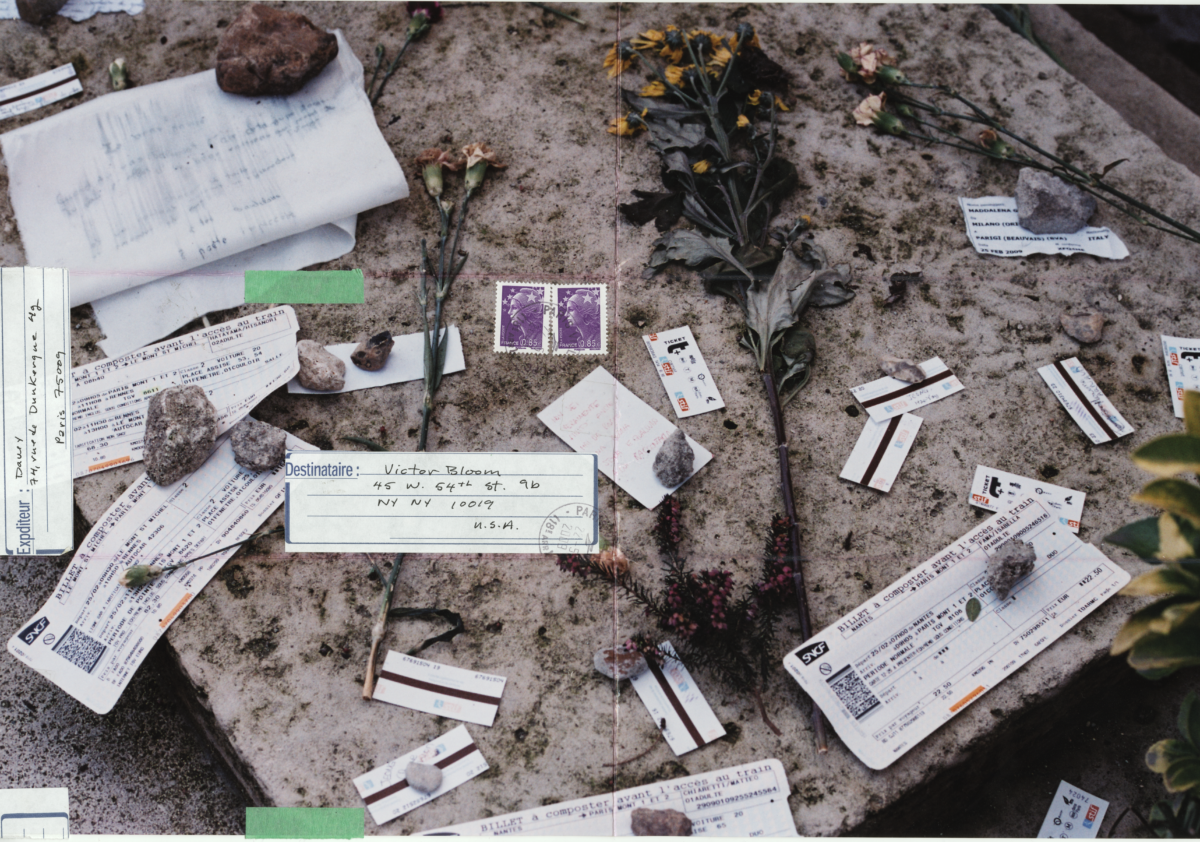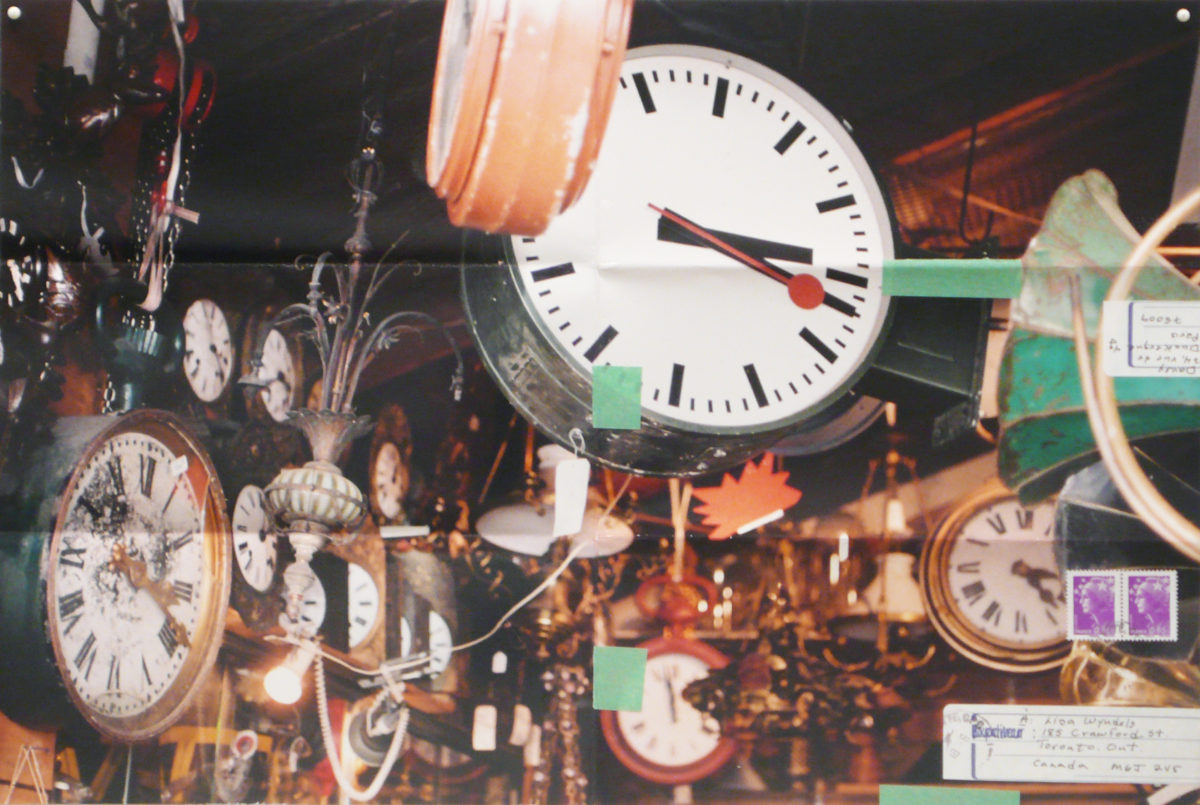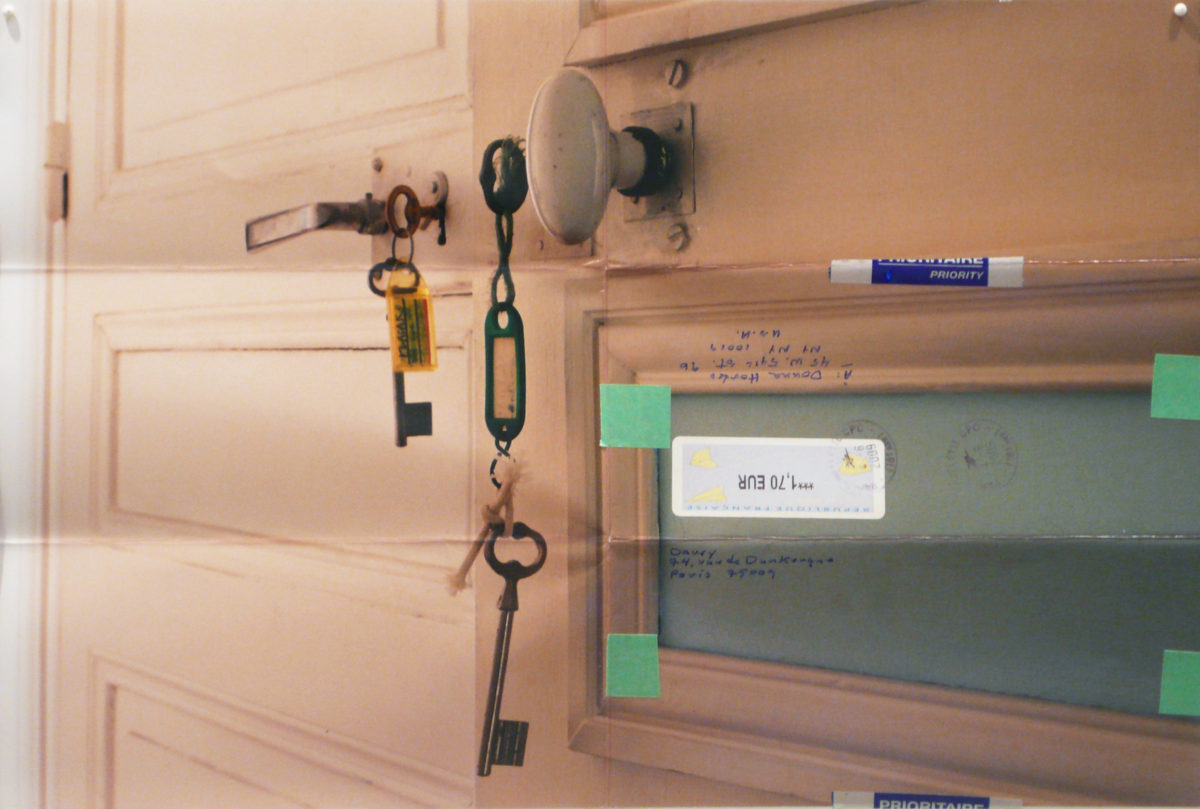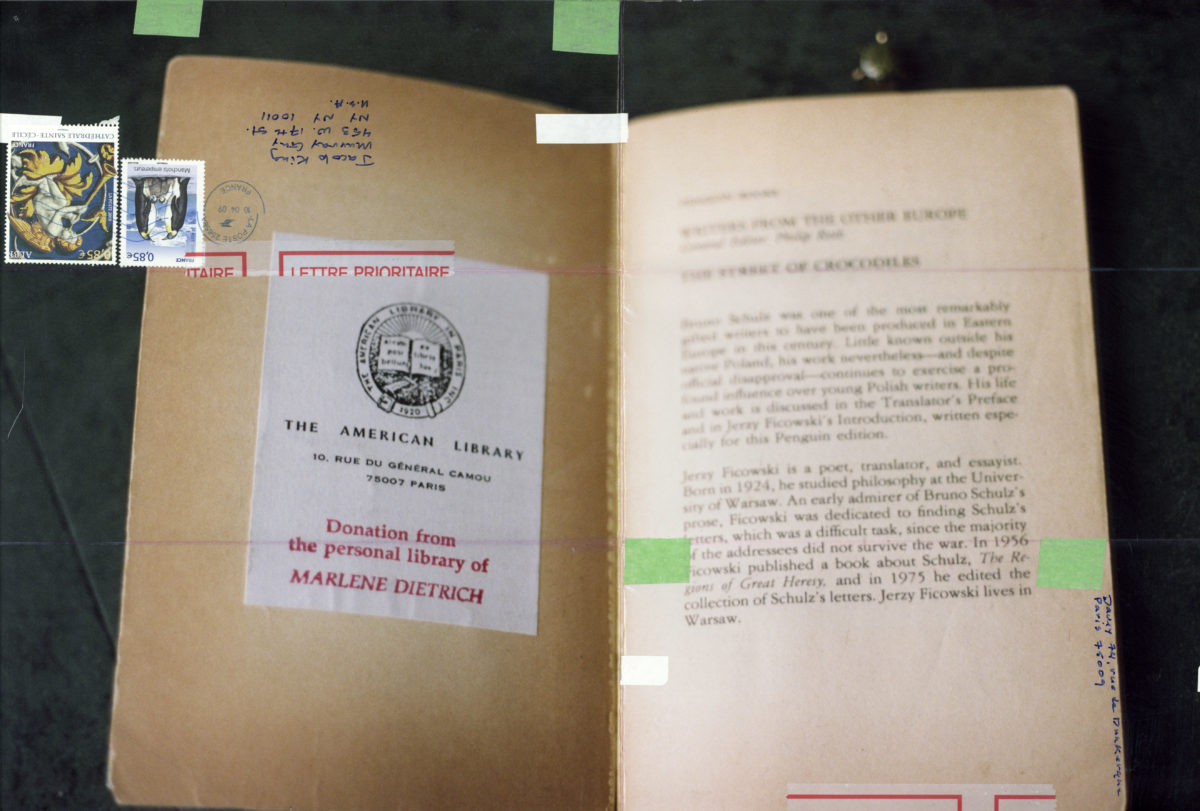
“The more ‘honestly’ you put yourself into the story, the more that story will concern others as well.”
—Rainer Werner Fassbinder
Correspondence, both conceptual and literal, is vital to Moyra Davey’s work.
Her fragmented writings, photographs, and film all swing between the autos—auto-biography, auto-fiction and auto-theory. Davey draws uncanny lines between the work of a divergent suite of writers, artists, and thinkers from Mary Wollstonecraft to Jane Bowles, Walter Benjamin to Chantal Ackerman. These radiant connections often serve as a means to both create and to understand her own process, her life. Davey rests at the intersection of these connections—she is her own confessional, desiring subject.
Reading is her petrol and she finds the letters of other writers to be of particular charge. In a brief reflection on the letters of Bowles, Davey notes, “I’ve often thought that diaries and letters are the real modernism: stream of consciousness without the contrivance”. Over the course of the past decade, Davey has taken to folding her digitally C-printed photographs into an epistolary form—post-marking and addressing directly on the image’s surface. The unprotected photographs are then dropped into mailboxes and carried off, over land or sea, to a friend or a curator at an exhibition site where they are unfolded and displayed as is, in arrangements according to specific instruction mapped out by Davey. When the occasional photograph is by chance lost and fails to arrive, an empty space is left on the wall in its place. And then there are her own exchanges too—the abiding and driving email dialogues between artists and writers in her circle.
Her entire process itself has, in a way, become one holistic correspondence. The early photography tended toward documenting friends and family (she is one of six sisters) though she eventually turned almost entirely away from recording the human figure for nearly twenty years. Instead, Davey took to making portraits of the quieter, inanimate corners of the everyday: dust, bottles, books, interiors, money, cemeteries.
In the early 2000s, confronting what she calls an “impasse,” Davey came to making video which she decided would “take root in words.” She began writing the text for what would become her first film, Fifty Minutes, which she performs as a narration on screen. This process took hold—Davey has produced eight narrative videos since. Photographs from her archive make appearances throughout her films too. She seems to perpetually glance back in order to look forward. This propagates the incestuous slant in her practice, where the work in one medium is taken up in another. Davey follows the dérive—welcoming the accident, the slippage, the digression, the drift.
Index Cards, published in May by New Directions, brings together a collection of fifteen texts Davey wrote between 2003 and 2019, several of which serve as the narrative scripts for her films. Reading the pieces, one after the next, I found myself thinking of Robert Morris’s sculpture Box with The Sound of Its Own Making (1961). Projected from a speaker within a wooden box is a three and a half hour recording of the process of the box’s construction that plays on loop. There is hammering, sanding, sawing, and many silences too as Morris takes breaks or fetches more supplies. Davey’s texts are themselves records of their formations. Her process is reported live on the page—the thinking, the building, the silences, even the fetching of more supplies.
We spoke during the waning days of New York City’s lockdown about her new book, process, productivity and the perpetual sites of return in her work. Davey phoned in from Provincetown, Massachusetts.
—Eliza Barry
THE BELIEVER: Would you speak to how you approached putting these texts side by side—the selecting, the ordering?
MOYRA DAVEY: Nicolas Linnert, the editor, made the selection. Tynan Kogane at New Directions had input as well but it was basically Linnert who chose and ordered the texts, and the photographs. He’s a brilliant guy whom I really trust. He knows my work well (he also edited two of my videos) and he’s an astute reader who perceived the connections and themes that flow and build on each other. Reading the manuscript, I was struck by all the linkages he found, things I would never have seen because I am way too close to the material. He made me re-discover things about the writing. The texts are full of this method of making correspondences, and then the editor in turn does a similar thing, in his sequencing of them.
BLVR: With the fragments placed one after the next there is a sense of ongoingness that extends beyond the self contained pieces. This ongoingness doesn’t feel necessarily linear though, even in “Index Cards” (the essay) where dates often serve as headers for the fragments and progress chronologically. Index cards themselves, unlike a diary or log, can be shuffled about, re-arranged, by hand, by chance—How do you think about time in relation to the fragment?
MD: I think the ongoingness you mention has partly to do with revisiting themes, and even quoting myself in different contexts. The essay “Index Cards” is indeed the most fragmented in the collection and barely has a structure, except that its assemblage takes place over the course of a year. It is very close to my heart because I can re-read it and it brings back all the intensity of that time. I’d recently been diagnosed with MS and was in a heightened, steroid-induced state when I wrote the piece. I was thinking a lot about people who’d written of their illnesses: Jane Bowles and Aldo Rossi, and Walter Benjamin and Bruno Schulz who suffered greatly and perished in the Holocaust. “Index Cards” is anchored by dates and locales from the years 2008-09 when I composed it, but the longer fragments I cite by my core-authors seem to me out-of-time and to this day I can read their words embedded in my chronology and feel I’m encountering them for the first time.
BLVR: Do you think of the photograph as being fixed in time, or having an ongoingness too?
MD: Most photographs contain details that point to the time of their making, but many portraits of artists, filmmakers, writers can have an ongoingness if the work of the portrait-subject retains a currency for us. I recently watched a short film documenting Pasolini which feels remarkably contemporary, probably also helped by the fact that he looks like Willem Dafoe.

BLVR: The essays and writings often serve as the scripts or scores which you recite and perform in your videos. Do you see the video work as inhabiting a liminal space or as a bridge between your writing and photography?
MD: Yes, definitely. The video is often the space that brings together writing and photographs.
BLVR: The role of chance is threaded and employed throughout the texts—you consider the ways in which an engagement with the aleatory drive your reading, writing, photography and video work.
MD: I’m a reader, and I rely on reading to write. But I also like to feel that when I read I’m connected, either to someone in my orbit, or to other books. To this end I rely on chance encounters to determine some of my reading. It’s also just one system among many for narrowing choice. There’s almost a feeling of superstition attached to the things that get thrown in your path, when you decide you’re going to pay attention to a certain book for some obscure reason, and it leads you to a generative place.
BLVR: Across the texts you wrestle with some conflicting instincts: the enduring need to create and generate work, the feeling that “the last thing we need is more product,” and as you put it the desire “to have once and for all made the thing that will end the need to make things.” How do you reconcile these incongruent impulses?
MD: When I hear you list those phrases… I have to say, I’m really scrupulous about attributions. Those are not just my ideas. Many writers have voiced those conflicts, and yes I have the same dilemmas.
BLVR: How do you feel today?
MD: The last video I made really took it out of me. (It was supposed to show at MoMA in May, as part of the Modern Mondays series).Video is the most physically demanding thing I do, it requires the most stamina, and physical and mental fatigue are ongoing concerns. But at the same time, I have this need to keep on making. I quote Delphine Seyrig telling Chantal Akerman: “you have to make make make” and I identify with that 100%. I’ve been like that since I was a teenager and I’ve also had unhappy stretches of being unproductive and blocked.
BLVR: You speak to the legitimacy of writer’s block in Index Cards and make a great note about artists not having a “common designation for similar stoppage.”
MD: Making, and the availability of making and play are somehow thought to be ongoing practice for artists …The thing about photography especially now—which speaks to the comment I made some years ago: “do we really need more product” —there’s just so much photography— this was true even with analog. I remember my students at ICP in the 2000s, grappling with it, one of them, Matt Porter memorably said: “no more boring photographs”! With digital photography and digital cinema there is almost nothing limiting you. Every time I take a photograph now I think of all the photographs I’ve made myself and all of the photographs of others… and you have to ask yourself the question: who needs this?
BLVR: Yes—or how much do we need?
MD: And now we think of the the carbon footprint as well. There are so many questions that come up around production, but if you’re someone who has the drive and the need to make, you’re constantly negotiating that.
BLVR: The curse and blessing.
MD: Yes, like Chekhov said “if life is given only once, why spend it writing, why not go fishing?” So many writers have expressed those kinds of ambivalent feelings, especially the ones who have a disciplined daily practice of four hours of secluded work. I don’t know how they do it.

BLVR: Do you work within any sort of regular structure or impose any rules upon yourself?
MD: No. I write in the mornings, it’s absolutely my optimum time, but I don’t have a fixed number of hours or word count. I’ve tried. I had a studio in Paris, and a grant, and that’s when I wrote “Index Cards” and made the video My Necropolis. I went there every day “chained myself to the desk.” It was so hard, honestly. One day I had an epiphany about the video, it was like divine intervention providing me with a solution and I felt saved.
BLVR: Is there anything you do entirely outside of reading and writing and corresponding that feels particularly generative?
MD: When I’m running I will sometimes suddenly get ideas—your mind is wandering, available in a different way. Barthes said, “il ne faut pas viser la chose”—i.e. don’t have the thing in your sights, come at it circuitously, or ‘slant’ as Emily Dickinson said.
BLVR: The same Fassbinder quote emerges in both One Year, and Index Cards: “The more ‘honestly’ you put yourself into the story, the more that story will concern others as well.”—To whom do you write? Are you writing towards someone or something?
MD: I love that line by Fassbinder. Chantal Ackerman too has expressed something very similar too.
BLVR: Yes! I have that Ackerman quote written down right here—“I haven’t tried to find a compromise between myself and others. I have thought that the more particular I am, the more I address the general.”
MD: PJ Harvey also said it in an interview I happened upon on YouTube. I have a small collection of artists articulating that thought with slight variations.
Initially I’m writing for certain individuals who are very close to me, people who comment, tell me the thing is not shit and give me confidence to continue. Alison Strayer is a constant presence when I write. My partner, Jason Simon is really brilliant with feedback, Nicolas Linnert as well. I’m fortunate to have this core group of people, and others will surface at different times. Beyond this intimate circle I just mentioned, I’m not consciously thinking of a readership. I don’t know if I have an answer…
BLVR: Perhaps it doesn’t need an answer…
MD: Clearly I imagine a readership though, if I take to heart Fassbinder, Akerman, PJ Harvey and also Borges, who wrote about his audiences craving his confessions rather than the expository parts of his lectures. He talks about this in a beautiful essay called “Blindness,” where he says: “People always hope for confessions, and I have no reason to deny them mine.”





